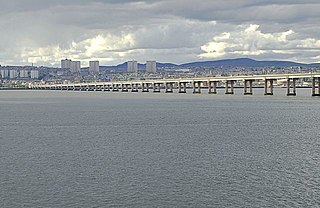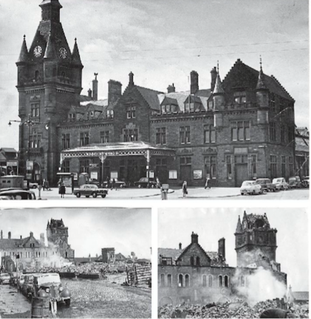Design, construction and demolition
The first arch, designed by harbour engineer James Leslie, was made out of wood. Following a design competition [4] for a more permanent structure, John Thomas Rochead, designer of the Wallace Monument near Stirling, was commissioned to design a permanent sandstone monument to replace the wooden arch. The Royal Arch, commonly known in Dundee as the Victoria Arch, was described as being in the "Anglo-Norman" style and consisted of a large triumphal arch, flanked by two smaller side arches, surmounted by two central turrets. It was situated between King William IV Dock and Earl Grey Dock on the south side of Dock Street, between the junctions of Castle Street, and Whitehall Crescent. The structure was 80 feet (24 m) across. Costing between £2,270 and £3,000, it was mostly funded by public subscription and the harbour trustees.
The arch was demolished on 16 March 1964, as part of land reclamation work required for the construction of the Tay Road Bridge. The structure was dynamited and the rubble deposited in both the King William IV and the Earl Grey Docks. Afterwards, the docks were land-filled to accommodate the slip roads for the new road bridge.

Dundee is Scotland's fourth-largest city and the 51st-most-populous built-up area in the United Kingdom. The mid-year population estimate for 2016 was 148,210, giving Dundee a population density of 2,478/km2 or 6,420/sq mi, the second-highest in Scotland. It lies within the eastern central Lowlands on the north bank of the Firth of Tay, which feeds into the North Sea. Under the name of Dundee City, it forms one of the 32 council areas used for local government in Scotland.

The Tay Road Bridge carries the A92 road across the Firth of Tay from Newport-on-Tay in Fife to Dundee in Scotland, just downstream of the Tay Rail Bridge. At around 2,250 metres (1.4 mi), it is one of the longest road bridges in Europe, and was opened in 1966, replacing the old Tay ferry.

Broughty Ferry is a suburb of Dundee, Scotland. It is situated four miles east of the city centre on the north bank of the Firth of Tay. The area was a separate burgh from 1864 until 1913, when it was incorporated into Dundee. Historically it is within the County of Angus.

The Carse of Gowrie is a stretch of low-lying country in the southern part of Gowrie, Perth and Kinross, Scotland. It stretches for about 20 miles along the north shore of the Firth of Tay between Perth and Dundee. The area offers high-quality agricultural land and is well known as a major area for strawberry, raspberry and general fruit growing. Fruit is easy to cultivate in the area because of its southerly aspect and low rainfall. It has been suggested that monks brought new varieties of apples and pears to the area in the Middle Ages and there may have been vineyards growing on slopes near the River Tay.

Brechin is a town and former Royal burgh in Angus, Scotland. Traditionally Brechin was described as a city because of its cathedral and its status as the seat of a pre-Reformation Roman Catholic diocese, but that status has not been officially recognised in the modern era.

Tayside was one of the nine regions used for local government in Scotland from 16 May 1975 to 31 March 1996. The region was named for the River Tay.

Dundee railway station serves the city of Dundee on the east coast of Scotland. It is situated on the northern, non-electrified section of the East Coast Main Line, 59+1⁄4 miles (95.4 km) northeast of Edinburgh. Dundee is the tenth busiest station in Scotland. In January 2014, the former main station building was demolished to make way for a new building as part of the Dundee Waterfront Project which opened on 9 July 2018.

Taymouth Castle is situated to the north-east of the village of Kenmore, Perth and Kinross, in the Highlands of Scotland, in an estate which encompasses 450 acres. It lies on the south bank of the River Tay, about a mile from Loch Tay, in the heartland of the Grampian Mountains. Taymouth is bordered on two sides by mountain ranges, by Loch Tay on the third and by the confluence of the rivers Lyon and Tay on the fourth.
Dundee is the fourth-largest city in Scotland with a population of around 150,000 people. It is situated on the north bank of the Firth of Tay on the east coast of the Central Lowlands of Scotland. The Dundee area has been settled since the Mesolithic with evidence of Pictish habitation beginning in the Iron Age. During the Medieval Era the city became a prominent trading port and was the site of many battles. Throughout the Industrial Revolution, the local jute industry caused the city to grow rapidly. In this period, Dundee also gained prominence due to its marmalade industry and its journalism, giving Dundee its epithet as the city of "jute, jam and journalism".
Until the industrial revolution, the current City Centre represented the full extent of the City of Dundee, Scotland. Now roughly encircled by the market gait dual carriageway, the city centre is now the main shopping and commercial district. Unlike the city centre of Glasgow, many of the city centre's streets are not built on a grid plan and in that way have more in common with the street plan of the Old Town of Edinburgh.

North Carr is the last remaining Scottish lightship. She is 101 feet (31 m) in length, 25 feet (7.6 m) in beam and 268 tons.

Aberdeen Harbour, rebranded as the Port of Aberdeen in 2022, is a sea port located in the city of Aberdeen on the east coast of Scotland. The port was first established in 1136 and has been continually redeveloped over the centuries to provide a base for significant fishing and ship building industries. Since the 1970s it has provided support to the offshore oil and gas industry operating in the North Sea and it is the main commercial port in the north east of Scotland.

Dundee West railway station served the city of Dundee, Scotland, from 1847 to 1965 on the Dundee and Perth Railway. Author John Minnis has described demolition of the "wonderful" station building as "perhaps the most tragic loss" of a piece of railway architecture in Scotland.

Murthly is a village in Perth and Kinross, Scotland. It lies on the south bank of the River Tay, 5 miles southeast of Dunkeld, and 9+1⁄2 miles north of Perth. Perth District Asylum, later known as Murthly Hospital, was opened in the village on 1 April 1864 for 'pauper lunatics'. It was the second district asylum to be built in Scotland under the terms of the Lunacy (Scotland) Act 1857. It closed in 1984 and was later demolished. The village has a stone circle, in the former grounds of the hospital. The village formerly had a railway station on the Perth and Dunkeld Railway, which closed in 1965.

Lady Stair's House is a building, completed in 1892, which stands in Lady Stair's Close in Lawnmarket, Edinburgh, Scotland. The structure is a Category A listed building, having received its designation in 1970. Today it is home to the Writers' Museum.

Tayside House was an office block development in the city centre area of Dundee. The building served as the headquarters for Tayside Regional Council and its successor organisation following local government reorganisation, Dundee City Council. Tayside Police leased part of the building, which formed the city centre police station.

The Albert Bridge is a road bridge that spans the River Clyde in Glasgow, Scotland, near Glasgow Green. The bridge opened in 1871. It links the Saltmarket in the city centre with Crown Street on the city’s south side. It is category A listed, and named after Queen Victoria's consort, Prince Albert.

V&A Dundee is a design museum in Dundee, Scotland, which opened on 15 September 2018. The V&A Dundee is the first design museum in Scotland and the first Victoria and Albert museum outside London. The V&A Dundee is also the first building in the United Kingdom designed by Kengo Kuma.

J and C Carmichael was founded in 1810 at Ward Foundry, Session Street, Dundee, Scotland. The partners were James Carmichael (1776–1853) and his younger brother Charles Carmichael (1782–1843).

The timeline of Dundee history shows the significant events in the history of Dundee, Scotland.




















